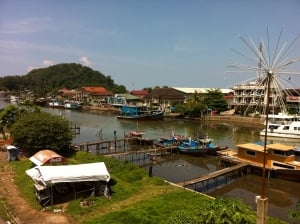Padang after the earthquake
Research news
Kristal Buckley and Steve Cooke from Deakin's Cultural Heritage Centre for Asia and the Pacific visited Padang recently to explore the potential for cultural tourism in the city.
Padang, in Indonesia's West Sumatra, was hit by a major earthquake in 2009 that caused widespread loss of life. The earthquake also damaged the fabric of the city, including significant cultural heritage.
Although traditionally a gateway for tourists to other parts of the region, the potential for tourism in Padang itself is under-explored and the local government is keen to establish cultural tourism in the area as a way of helping the region recover from the earthquake.
The research, partly funded through the Australia Indonesian Institute for Humanity and Development (AIIHD), centred around the city's Old Quarter along Jalan Batang Arau, made up of former Dutch and Chinese warehouses.
While there, Kristal and Steve were hosted by colleagues from Padang State University, Professor Irianto and Professor Gistituati, who, along with Deakin’s Dr Jonathan Sweet, are research partners in the project. During a busy week, they began the process of mapping the cultural precincts and character of the old city, noting also damaged areas and the conservation and re-development work that has already started.
They held discussions with the Mayor of Padang and met with tourism officials to explore existing and future plans for tourism development, particularly around the former port area. They visited key regional towns such as Batusangkar and Bukittinggi, looking at key cultural tourism sites and meeting with officials to understand the role of cultural tourism in local economic development and how these sites are networked within the tourism industry.
They also spoke with the Director of the State Museum of Padang (Adityawarman Museum) to hear about conservation of building and objects damaged by the earthquake, and discuss the redevelopment of the displays within the context of the relationship between cultural heritage and Indonesian identity.
A number of issues were raised during the visit that may form the basis of future research.
Although there has been significant interest in heritage immediately after the earthquake, evidenced by reports produced by the Prince Claus Trust, UNESCO and the World Monuments Fund, little research has been carried out on how this interest translates into the conservation of cultural heritage over time and its role in the rejuvenation of the life of the city. With the destruction and/or continued deterioration of many key sites, particularly along Jalan Batang Arau, a relatively intact urban landscape has been disrupted.
At present, no design and development guidelines are in place to shape the rejuvenation of this area, and the area appears to be at risk of further deterioration or large-scale re-development. Infill which exceeds the traditional height of the waterfront is already evident.
An opportunity exists for Australian and Indonesian academics to work together with local government officials to develop appropriate guidelines to balance heritage conservation with economic development. The visit also prompted potential teaching links.
Building on the existing strong connections with Indonesian universities developed by AIIHD, Deakin staff are also exploring the development of cultural heritage field schools, joint degrees and student exchanges with universities in Padang, including Bung Hatta University, which has an architecture department and a significant track record in cultural heritage work.
The visit raised a number of issues relating to cultural tourism, and the Deakin team hope to visit again in the near future to continue working with university, industry and governments partners.
Share this story
 The historic waterfront along Jalan Batang Arau, extensively damaged in the 2009 earthquake.
The historic waterfront along Jalan Batang Arau, extensively damaged in the 2009 earthquake.
